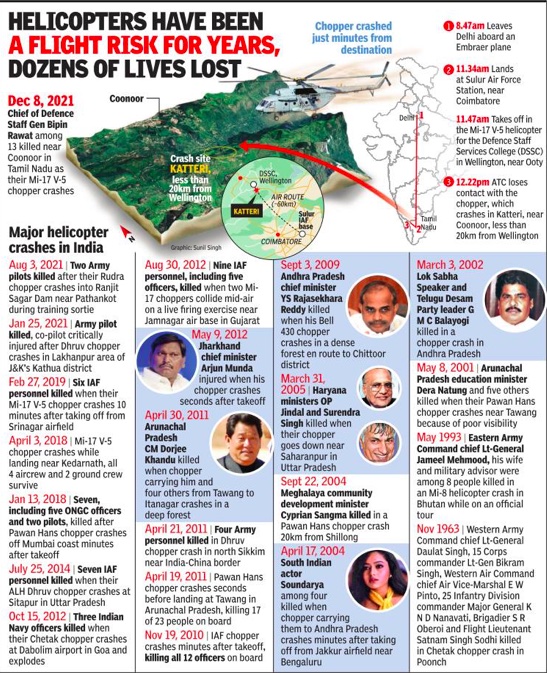Helicopters (defence forces): India
This is a collection of newspaper articles selected for the excellence of their content. |
Contents |
Helicopters
Major crashes
1963- 2021

From: Dec 9, 2021: The Times of India
See graphic:
Major Helicopter crashes in India, 1963- 2021
Cheetah helicopters
Status of fleet in 2016
Rajat Pandit: Dec 1, 2016: The Times of India

Aging, obsolete chopper fleets take toll on military
Old and obsolete machines, whether they be fighters or helicopters, continue to exact a heavy toll in the armed forces. Three Army officers were killed and a soldier critically injured when their Cheetah helicopter crashed at Sukna military station in West Bengal on Wednesday , in yet another grim reminder of the military's ageing light utility helicopter fleets.
The Cheetah, being flown by Majors Sanjeev Lathar and Arvind Bazala, was about to land after a reconnaissance mission in forward areas when it crashed at 11.45 am.Lt-Colonel Rajneesh Kumar, posted in the operations wing of 33 Corps, was also killed in the crash, while sapper Dhamne Yogesh Bhaskar is in a critical condition at Bengdubi military hospital.
Incidentally , another Cheetah helicopter, which landed just before the ill-fated one, had the chief of staff of 33 Corps, Major General Vikal Shahni, on board. “There was a sudden technical snag in the chopper that crashed. It could be engine failure or tail-rotor cable rupture,“ said an officer.
Though the court of inqui ry will establish the exact cause, the crash once again underlines that the armed forces are being forced to fly old single-engine Cheetahs in the absence of modern twin-engine choppers. Failure of successive governments to take timely decisions, shoddy performance of defence PSU Hindustan Aeronautics (HAL) and recurring corruption scandals have all combined to lead to this abysmal situation.
CheetahChetak light utility helicopters, in fact, are now increasingly being dubbed the “MiGs of the chopper fleets“ due to their high crash rates and poor serviceability .In March last year, a group of wives of Army officers had even petitioned defence minister Manohar Parrikar to stop the use of these “outdated“ helicopters to avoid casualties.
Based on the 1960s' technologies, Cheetahs are bereft of modern avionics like ILS (instrument landing), omnidirectional and ranging systems or FADEC (full authority digital engine controls). “Over 50% of choppers in Army aviation fleet are well over 30 years old.Moreover, it has just 70% of its authorised helicopter strength, which includes around 140 Cheetahs, 50 Chetaks and 80 Dhruv advanced light helicopters,“ said an officer.
After the procurement of 197 new light utility helicopters from aboard was scrapped three times over the last decade due to technical deviations and corruption allegations, the NDA government in August 2014 decided they would be “Made in India“ with foreign collaboration.
But the much-touted joint venture with Russia for 200 Kamov-226T light utility helicopters for around $1 billion is yet to kick off. While the first 60 choppers will come from Russia, the rest are to be produced in India over nine years.
In a double whammy , HAL is also far away from delivering 187 light helicopters it was supposed to make “within 60 months“ when another project was sanctioned by the Cabinet Committee on Security in February 2009.
Deployment in the Indian Defence Forces
Helicopter Fleets in the Indian Defence Forces

See graphic:
Helicopters deployed in rescue operations
Light combat helicopters
2022
Rajat Pandit, March 31, 2022: The Times of India
New Delhi: The PM-led Cabinet Committee on Security cleared the first-ever contract for 15 indigenously designed and manufactured light combat helicopters (LCHs) for the IAF and Army at a cost of Rs 3,887 crore, along with infrastructure sanctions worth Rs 377 crore. Ten of these weaponised twin-engine choppers in the weight class of 5-8 tonne are meant for the IAF, while the Army will get five. The overall requirement for such helicopters is pegged at 160 in the coming years.
Designed and developed by defence PSU Hindustan Aeronautics (HAL), two LCHs were even deployed in eastern Ladakh in 2020 to flight-evaluate them amidst the still-continuing military confrontation with China.
Even before the actual approval, HAL had launched the “limited series production (LSP)” of the 15 LCHs at its Bengaluru facility in anticipation of the order. “The LSP choppers have 45% in- digenous content by value, which will progressively increase to more than 55% for the next version,” a defence ministry official said.
With the contract to be inked, as per the HAL. LCH is the only attack helicopter in its weight class in the world which can land and take-off at an altitude of 5,000-metre or 16,400-feet with a considerable load of weapons and fuel. Equipped with 70mm rockets, missiles and chin-mounted cannons, the MoD said the LCH has the requisite agility, manoeuvrability, extended range, stealth features, high-altitude performance and around-theclock all-weather capabilities for several combat missions.
They range from destruction of enemy air defences, anti-tank operations and high- altitude bunker busting missions to counter-insurgency and search and rescue combat roles. “The LCH would be a potent platform to meet the operational requirements of IAF and Army, the officialsaid.
The LCH also had the distinction of being the first attack helicopter to land at forward bases in the Siachen Glacier-Saltoro Ridge region, 4,700 meters above sea level with a 500-kg load. Such LCHs also figured in the defence ministry first negative arms import list or “positive indigenisation list” announced in August 2020, under which acquisition of 101 weapon systems and platforms from abroad will be progressively banned in the 2020-25 timeframe to bolster the fledgling domestic defence production sector.